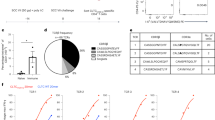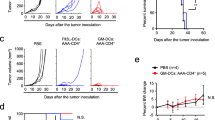Abstract
Background
Advanced non-small cell lung cancer (NSCLC) remains an incurable disease. Immunotherapies that activate patients’ T cells against resident tumor cells are being developed; however, these approaches may not be effective in NSCLC patients due to tumor-induced immune suppression. A major cause of immune suppression is myeloid-derived suppressor cells (MDSC). Because of the strategic role of CD4+ T lymphocytes in the activation of cytotoxic CD8+ T cells and immune memory, we are developing cell-based vaccines that activate tumor-specific CD4+ T cells in the presence of MDSC. The vaccines are NSCLC cell lines transfected with costimulatory (CD80) plus major histocompatibility complex class II (MHC II) genes that are syngeneic to the recipient. The absence of invariant chain promotes the presentation of endogenously synthesized tumor antigens, and the activation of MHC II-restricted, tumor-antigen-specific CD4+ T cells.
Methods
Potential vaccine efficacy was tested in vitro by priming and boosting peripheral blood mononuclear cells from ten NSCLC patients who had varying levels of MDSC. CD4+ T cell activation was quantified by measuring Type 1 and Type 2 cytokine release.
Results
The vaccines activated CD4+ T cells from all ten patients, despite the presence of CD33+CD11b+ MDSC. Activated CD4+ T cells were specific for NSCLC and did not cross-react with tumor cells derived from non-lung tissue or normal lung fibroblasts.
Conclusions
The NSCLC vaccines activate tumor-specific CD4+ T cells in the presence of potent immune suppression, and may be useful for the treatment of patients with NSCLC.




Similar content being viewed by others
Abbreviations
- Ii:
-
Invariant chain
- MDSC:
-
Myeloid-derived suppressor cells
- NSCLC:
-
Non-small cell lung cancer
- XRT:
-
Radiotherapy
References
Almand B, Clark JI, Nikitina E, van Beynen J, English NR, Knight SC, Carbone DP, Gabrilovich DI (2001) Increased production of immature myeloid cells in cancer patients: a mechanism of immunosuppression in cancer. J Immunol 166:678–689
Armstrong TD, Clements VK, Martin BK, Ting JP, Ostrand-Rosenberg S (1997) Major histocompatibility complex class II-transfected tumor cells present endogenous antigen and are potent inducers of tumor-specific immunity. Proc Natl Acad Sci USA 94:6886–6891
Atanackovic D, Altorki NK, Stockert E, Williamson B, Jungbluth AA, Ritter E, Santiago D, Ferrara CA, Matsuo M, Selvakumar A, Dupont B, Chen YT, Hoffman EW, Ritter G, Old LJ, Gnjatic S (2004) Vaccine-induced CD4+ T cell responses to MAGE-3 protein in lung cancer patients. J Immunol 172:3289–3296
Baskar S, Glimcher L, Nabavi N, Jones RT, Ostrand-Rosenberg S (1995) Major histocompatibility complex class II+B7-1+ tumor cells are potent vaccines for stimulating tumor rejection in tumor-bearing mice. J Exp Med 181:619–629
Bosch JJ, Thompson JA, Srivastava MK, Iheagwara UK, Murray TG, Lotem M, Ksander BR, Ostrand-Rosenberg S (2007) MHC class II-transduced tumor cells originating in the immune-privileged eye prime and boost CD4+ T lymphocytes that cross-react with primary and metastatic uveal melanoma cells. Cancer Res 67:4499–4506
Bronte V, Wang M, Overwijk WW, Surman DR, Pericle F, Rosenberg SA, Restifo NP (1998) Apoptotic death of CD8+ T lymphocytes after immunization: induction of a suppressive population of Mac-1+/Gr-1+ cells. J Immunol 161:5313–5320
Butts C, Murray N, Maksymiuk A, Goss G, Marshall E, Soulieres D, Cormier Y, Ellis P, Price A, Sawhney R, Davis M, Mansi J, Smith C, Vergidis D, MacNeil M, Palmer M (2005) Randomized phase IIB trial of BLP25 liposome vaccine in stage IIIB and IV non-small-cell lung cancer. J Clin Oncol 23:6674–6681
Danna EA, Sinha P, Gilbert M, Clements VK, Pulaski BA, Ostrand-Rosenberg S (2004) Surgical removal of primary tumor reverses tumor-induced immunosuppression despite the presence of metastatic disease. Cancer Res 64:2205–2211
Dissanayake SK, Thompson JA, Bosch JJ, Clements VK, Chen PW, Ksander BR, Ostrand-Rosenberg S (2004) Activation of tumor-specific CD4(+) T lymphocytes by major histocompatibility complex class II tumor cell vaccines: a novel cell-based immunotherapy. Cancer Res 64:1867–1874
Filipazzi P, Valenti R, Huber V, Pilla L, Canese P, Iero M, Castelli C, Mariani L, Parmiani G, Rivoltini L (2007) Identification of a new subset of myeloid suppressor cells in peripheral blood of melanoma patients with modulation by a granulocyte-macrophage colony-stimulation factor-based antitumor vaccine. J Clin Oncol 25:2546–2553
Finn OJ (2003) Cancer vaccines: between the idea and the reality. Nat Rev Immunol 3:630–641
Gabrilovich DI, Bronte V, Chen SH, Colombo MP, Ochoa A, Ostrand-Rosenberg S, Schreiber H (2007) The terminology issue for myeloid-derived suppressor cells. Cancer Res 67:425; author reply 426
Hirschowitz EA, Foody T, Hidalgo GE, Yannelli JR (2007) Immunization of NSCLC patients with antigen-pulsed immature autologous dendritic cells. Lung Cancer 57:365–372
Huang B, Pan PY, Li Q, Sato AI, Levy DE, Bromberg J, Divino CM, Chen SH (2006) Gr-1+CD115+ immature myeloid suppressor cells mediate the development of tumor-induced T regulatory cells and T-cell anergy in tumor-bearing host. Cancer Res 66:1123–1131
Janssen EM, Lemmens EE, Wolfe T, Christen U, von Herrath MG, Schoenberger SP (2003) CD4+ T cells are required for secondary expansion and memory in CD8+ T lymphocytes. Nature 421:852–856
Jemal A, Siegel R, Ward E, Murray T, Xu J, Thun MJ (2007) Cancer statistics, 2007. CA Cancer J Clin 57:43–66
Kaufman HLDisis ML (2004) Immune system versus tumor: shifting the balance in favor of DCs and effective immunity. J Clin Invest 113:664–667
Koch N, Wong GH, Schrader JW (1984) Ia antigens and associated invariant chain are induced simultaneously in lines of T-dependent mast cells by recombinant interferon-gamma. J Immunol 132:1361–1369
Kong F, Jirtle RL, Huang DH, Clough RW, Anscher MS (1999) Plasma transforming growth factor-beta1 level before radiotherapy correlates with long term outcome of patients with lung carcinoma. Cancer 86:1712–1719
Kusmartsev S, Gabrilovich DI (2002) Immature myeloid cells and cancer-associated immune suppression. Cancer Immunol Immunother 51:293–298
Kusmartsev SA, Li Y, Chen SH (2000) Gr-1+ myeloid cells derived from tumor-bearing mice inhibit primary T cell activation induced through CD3/CD28 costimulation. J Immunol 165:779–785
Letterio JJ, Roberts AB (1998) Regulation of immune responses by TGF-beta. Annu Rev Immunol 16:137–161
Muntasell A, Carrascal M, Alvarez I, Serradell L, van Veelen P, Verreck FA, Koning F, Abian J, Jaraquemada D (2004) Dissection of the HLA-DR4 peptide repertoire in endocrine epithelial cells: strong influence of invariant chain and HLA-DM expression on the nature of ligands. J Immunol 173:1085–1093
Nemunaitis J (2007) A review of vaccine clinical trials for non-small cell lung cancer. Expert Opin Biol Ther 7:89–102
Nemunaitis J, Dillman RO, Schwarzenberger PO, Senzer N, Cunningham C, Cutler J, Tong A, Kumar P, Pappen B, Hamilton C, DeVol E, Maples PB, Liu L, Chamberlin T, Shawler DL, Fakhrai H (2006) Phase II study of belagenpumatucel-L, a transforming growth factor beta-2 antisense gene-modified allogeneic tumor cell vaccine in non-small-cell lung cancer. J Clin Oncol 24:4721–4730
Nemunaitis J, Jahan T, Ross H, Sterman D, Richards D, Fox B, Jablons D, Aimi J, Lin A, Hege K (2006) Phase 1/2 trial of autologous tumor mixed with an allogeneic GVAX vaccine in advanced-stage non-small-cell lung cancer. Cancer Gene Ther 13:555–562
Nemunaitis J, Sterman D, Jablons D, Smith JW II, Fox B, Maples P, Hamilton S, Borellini F, Lin A, Morali S, Hege K (2004) Granulocyte-macrophage colony-stimulating factor gene-modified autologous tumor vaccines in non-small-cell lung cancer. J Natl Cancer Inst 96:326–331
O’Mahony D, Kummar S, Gutierrez ME (2005) Non-small-cell lung cancer vaccine therapy: a concise review. J Clin Oncol 23:9022–9028
Pulaski BA, Ostrand-Rosenberg S (1998) Reduction of established spontaneous mammary carcinoma metastases following immunotherapy with major histocompatibility complex class II and B7.1 cell-based tumor vaccines. Cancer Res 58:1486–1493
Raez LE, Cassileth PA, Schlesselman JJ, Padmanabhan S, Fisher EZ, Baldie PA, Sridhar K, Podack ER (2003) Induction of CD8 T-cell-Ifn-gamma response and positive clinical outcome after immunization with gene-modified allogeneic tumor cells in advanced non-small-cell lung carcinoma. Cancer Gene Ther 10:850–858
Raez LE, Cassileth PA, Schlesselman JJ, Sridhar K, Padmanabhan S, Fisher EZ, Baldie PA, Podack ER (2004) Allogeneic vaccination with a B7.1 HLA-A gene-modified adenocarcinoma cell line in patients with advanced non-small-cell lung cancer. J Clin Oncol 22:2800–2807
Raez LE, Rosenblatt JD, Podack ER (2006) Present and future of lung cancer vaccines. Expert Opin Emerg Drugs 11:445–459
Ramos TC, Vinageras EN, Ferrer MC, Verdecia BG, Rupale IL, Perez LM, Marinello GG, Rodriguez RP, Davila AL (2006) Treatment of NSCLC patients with an EGF-based cancer vaccine: report of a Phase I trial. Cancer Biol Ther 5:145–149
Serafini P, De Santo C, Marigo I, Cingarlini S, Dolcetti L, Gallina G, Zanovello P, Bronte V (2004) Derangement of immune responses by myeloid suppressor cells. Cancer Immunol Immunother 53:64–72
Shedlock DJ, Shen H (2003) Requirement for CD4 T cell help in generating functional CD8 T cell memory. Science 300:337–339
Shepherd FA (2000) Chemotherapy for advanced non-small-cell lung cancer: modest progress, many choices. J Clin Oncol 18:35S–38S
Shimizu J, Yamazaki S, Sakaguchi S (1999) Induction of tumor immunity by removing CD25+CD4+ T cells: a common basis between tumor immunity and autoimmunity. J Immunol 163:5211–5218
Sinha P, Clements V, Bunt SK, Albelda SM, Ostrand-Rosenberg (2007) Cross-talk between myeloid-derived suppressor cells and macorphages subverts tumor immunity towards a type 2 response. J Immunol 179:977–983
Sinha P, Clements VK, Ostrand-Rosenberg S (2005) Reduction of myeloid-derived suppressor cells and induction of M1 macrophages facilitate the rejection of established metastatic disease. J Immunol 174:636–645
Steimle V, Siegrist CA, Mottet A, Lisowska-Grospierre B, Mach B (1994) Regulation of MHC class II expression by interferon-gamma mediated by the transactivator gene CIITA. Science 265:106–109
Strober S (1984) Natural suppressor (NS) cells, neonatal tolerance, and total lymphoid irradiation: exploring obscure relationships. Annu Rev Immunol 2:219–237
Suzuki E, Kapoor V, Jassar AS, Kaiser LR, Albelda SM (2005) Gemcitabine selectively eliminates splenic Gr-1+/CD11b+ myeloid suppressor cells in tumor-bearing animals and enhances antitumor immune activity. Clin Cancer Res 11:6713–6721
Terabe M, Matsui S, Park JM, Mamura M, Noben-Trauth N, Donaldson DD, Chen W, Wahl SM, Ledbetter S, Pratt B, Letterio JJ, Paul WE, Berzofsky JA (2003) Transforming growth factor-beta production and myeloid cells are an effector mechanism through which CD1d-restricted T cells block cytotoxic T lymphocyte-mediated tumor immunosurveillance: abrogation prevents tumor recurrence. J Exp Med 198:1741–1752
Thompson JA, Dissanayake SK, Ksander BR, Knutson KL, Disis ML, Ostrand-Rosenberg S (2006) Tumor cells transduced with the MHC class II Transactivator and CD80 activate tumor-specific CD4+ T cells whether or not they are silenced for invariant chain. Cancer Res 66:1147–1154
Thompson JA, Srivastava MK, Bosch JJ, Clements V, Ksander BR, Ostrand-Rosenberg S (2007) The absence of invariant chain in MHC II cancer vaccines enhances the activation of tumor-reactive type 1 CD4+ T lymphocytes. Cancer Immunol Immunother 57:389–398
Young MR, Lathers DM (1999) Myeloid progenitor cells mediate immune suppression in patients with head and neck cancers. Int J Immunopharmacol 21:241–252
Zea AH, Rodriguez PC, Atkins MB, Hernandez C, Signoretti S, Zabaleta J, McDermott D, Quiceno D, Youmans A, O’Neill A, Mier J, Ochoa AC (2005) Arginase-producing myeloid suppressor cells in renal cell carcinoma patients: a mechanism of tumor evasion. Cancer Res 65:3044–3048
Acknowledgments
We thank Ms. Virginia Clements for her excellent technical assistance, Dr. Dean Mann for providing the PBMC, Dr. Pratima Sinha for her critique of the manuscript, and Ms. Chere Petty for help with the microscopy.
Author information
Authors and Affiliations
Corresponding author
Additional information
Grant support: NIH R01 CA115880, R01 CA84232, Susan G. Komen Breast Cancer Foundation for the Cure BCTR0503885 (S. Ostrand-Rosenberg); NIH R01EY016486 (B. Ksander); Fight for Sight, Inc. post doctoral fellowship, Dutch foundations: Rotterdamse Vereniging Blindenbelangen, Stichting Blindenhulp, Stichting Blinden-Penning, Stichting Dondersfonds, Stichting Nelly Reef Fund, Gratama Stichting, Stichting Admiraal van Kinsbergen Fonds, and Foundation ‘De Drie Lichten.’ (J. Bosch); DOD Breast Cancer Program pre-doctoral fellowship DAMD17-03-0337 (J. Thompson).
Rights and permissions
About this article
Cite this article
Srivastava, M.K., Bosch, J.J., Thompson, J.A. et al. Lung cancer patients’ CD4+ T cells are activated in vitro by MHC II cell-based vaccines despite the presence of myeloid-derived suppressor cells. Cancer Immunol Immunother 57, 1493–1504 (2008). https://doi.org/10.1007/s00262-008-0490-9
Received:
Accepted:
Published:
Issue Date:
DOI: https://doi.org/10.1007/s00262-008-0490-9




